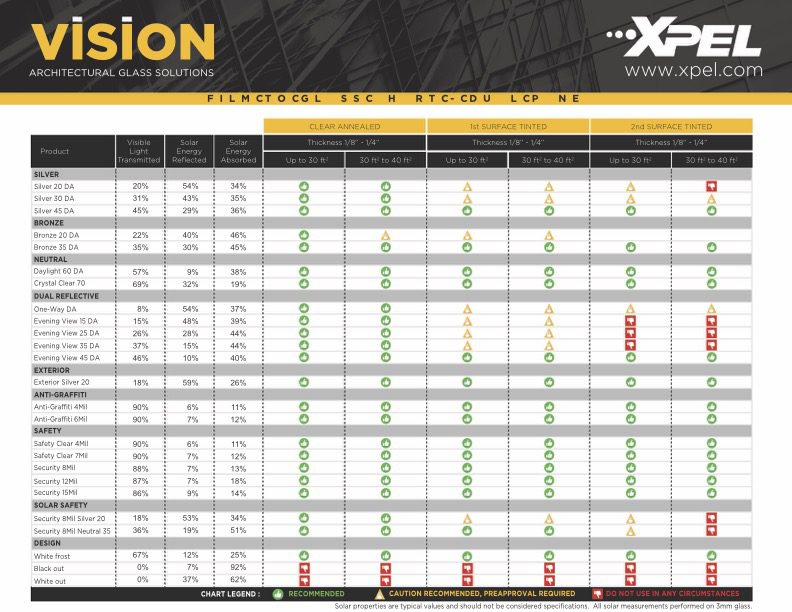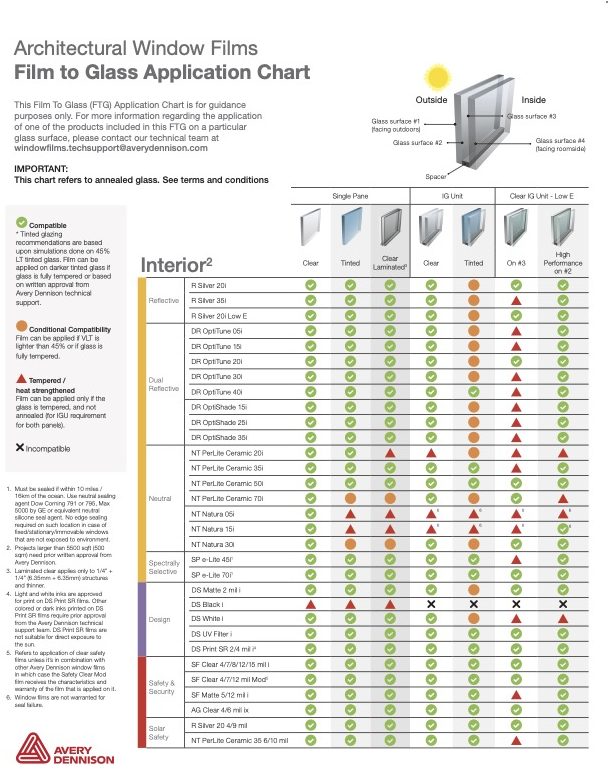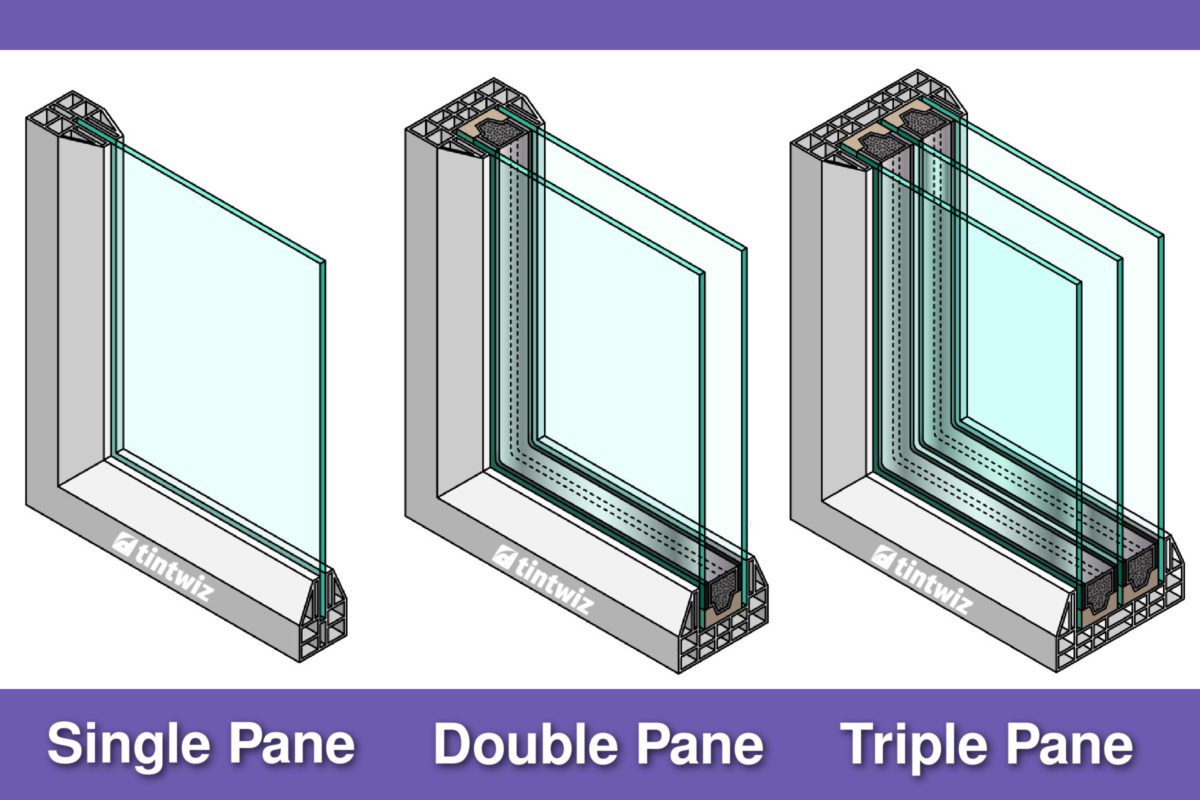When it comes to applying window film to a residential or commercial windows, knowing what type of glass you’re working with is important to ensure proper film to glass compatibility.
In this article, we’ll go over what you need to know when applying window tint to single, dual, and triple pane windows and as well as annealed glass, heat-strengthened glass, and tempered glass.
Table of contents
- Window Film Solar Absorption and Reflection
- Film to Glass Compatibility Chart
- Flat Glass Window Tint Software
- Window Tint Software Free Trial
- Glass Strengths
- Glass Types
- Is window film compatible with dual pane windows?
- Can you use window film on double glazed windows?
- Can you put reflective film on dual pane windows?
- Can you put window film on tempered glass?
- Does window film cause windows to crack?
- Can you put window film on Low E glass?
- Why is window film not recommended for dual pane windows?
- Is window film installed on the inside or outside?
Window Film Solar Absorption and Reflection
Solar window films work in two ways; absorbing the solar energy and / or reflecting it. The light and heat is coming at the window and it has to go somewhere so the two options are to absorb the solar energy or to reflective, or both.
Reflective Window Films
Reflective films are also known as “metallized” window films. The metal content make reflective window films exceptional at rejecting heat and filtering out glare – much more so than non-metalized alternatives.
Because metallized films work by reflecting the solar energy, they typically have a very low solar absorption, making them safe to apply to most types of glass. An example of an exception can be laminated glass or glass with metal wiring between the panes. In that case, a dark reflective film installed from the interior could cause thermal stress to the glass and seals.
Window Films That Absorption the Solar Energy
When applying a non-metallized window film on a home or business, it is especially important to note the type of glass the window film is being applied. The reason is a film that does not contain metal works by absorbing the solar energy in the film and glass.
Depending on the glass strength and whether it be a single, dual, or triple pane window will affect compatibility with some window films. Too much solar absorption can cause window seals to prematurely fail and the possibility of the window cracking. That is why its always important to identify what type of glass you’re working with and refer to your window film manufacturer’s “Film to Glass Compatibility Chart”
Film to Glass Compatibility Chart
Flat glass window film manufacturers provide a film to glass compatibility chart for quick reference as to what film can go on what glass. If ever uncertain, it is always advised to contact the film manufacturer and get their approval on the application. For the film warranty to be valid, the application must meet manufacturers specifications. Other than this film on that glass, other factors can also come into play like the size of the pane of the glass, its directional exposure, and even an overhang. When it doubt, as the film manufacturer.
Examples of film to glass compatibility charts:


Flat Glass Window Tint Software
Residential and commercial window tinting projects involve many details that go beyond what is typically experiences with automotive window tinting.
Residential and commercial window tinting, also known as flat glass window tinting, often starts with an in person visit to the project site to measure the glass, inspect the project, and provide samples to the customer.
It is absolutely essential to be organized and efficient so you are able to accurately and quickly provide a clear detailed quote to the customer right there on the spot. Providing the flat glass window film quote to the customer during the consultation gives the customer a better experience since they can review it with the options fresh on their mind and you there to answer any questions.
Whether they accept the quote there on the spot or a few days later, using Tint Wiz window tint software will allow you do view the details of the job anytime, from anywhere which means when your or your installer goes to the job, they will know exactly what film goes where, what the windows look like, the direction their facing, etc making for an efficient installation and a great experience for your team and your customer.
Window Tint Software Free Trial
Tint Wiz comes with a 30 day completely free and unlimited trial which means you can download the app and use Tint Wiz with absolutely no cost or obligation.
Glass Strengths
Annealed Glass
Annealed Glass, sometimes called standard glass is a softer glass that has been thermally treated and then slowly cooled to relieve any internal stresses. Annealed glass tends to break into longer, jagged shards which can cause significant injury. It is generally used when strength or safety are not concerns but cost is.

Heat-Strengthened Glass
With Heat-Strengthened Glass, the cooling process is slower, which means the compression strength is lower. In the end, heat-strengthened glass is approximately twice as strong as annealed, or untreated, glass.
The industry standard specification requirements for heat-treated or tempered glasses are ASTM C1048. For heat-strengthened glass, the requirement is a surface compression of 3,500 to 7,500 psi with no requirement for edge compression. Fully tempered glass will have either a minimum surface compression of 69 MPa (10,000 psi), or an edge compression of not less than 67 MPa (9,700 psi).

Tempered Glass
Tempered Glass or toughened glass is manufactured through a process of extreme heating and rapid cooling, tempered glass is much harder and stronger than normal glass. Another benefit of tempered glass is the ability to stand up to moderate heat (470°F).
With tempered glass, the cooling process is accelerated to create higher surface compression (the dimension of force or energy per unit area) and/or edge compression in the glass. It is the air-quench temperature, volume and other variables that create a surface compression of at least 10,000 pounds per square inch (psi). This is the process that makes the glass four to five times stronger and safer than annealed or untreated glass. As a result, tempered glass is less likely to experience a thermal break.

Glass Types

Single Pane Window
This type of glass is exactly as the name implies: a singular panel of glass that is clear. Single pane, clear glass has the highest rate of heat loss or heat gain (depending on the local climate), while permitting the highest daylight transmission.
Dual Pane Windows
Double pane glass is the most common type of glass used in today’s residential and commercial windows. It is constructed with two pieces of glass spaced apart and sealed to be airtight, forming a single-glazed unit. Also known as an insulating glass unit, double pane glass is designed to increase a window’s thermal performance by reducing the heat gain or loss. According to the Efficient Windows Collaborative, compared to single glazing, double-pane glass cuts heat loss in half due to the insulating air space between the glass layers. In addition to reducing the heat flow, a double-glazed unit with clear glass will allow the transmission of high visible light and high solar heat gain.
Triple Pane Windows
Triple Pane Windows aren’t as common as double-pane windows in most parts of the US. The main difference between double- and triple-pane windows is that triple-pane windows have three panes of glass instead of two.
A three-pane design means the window provides more insulation. If you live in an area with very cold winters, triple-pane windows can help minimize heat lost through your windows when it’s chilly outside.
Triple-pane windows is also a great option for noisy areas. That extra pane of glass makes a big difference in sound reduction. The two spaces between the three panes of glass are usually filled with krypton gas.
Other Glass Types
New advancements in technology and energy efficiency bring additional solutions to residential and commercial properties. Other glass types you may run into are Tinted Single Pane, Tinted Dual Pan, Low-E Dual Pane Surface 2, Low-E Dual Pane Surface 3, Low-E2 Both Surfaces, Low-E Dual Pane Surface 4, Clear Single Pane Laminated, Clear Dual Pane Laminated, Tinted Single Pane Laminated, Tinted Dual Pane Laminated, Heat Mirror
Is window film compatible with dual pane windows?
Yes, there are window films available that are compatible with dual pane windows. It is important to check the film to glass compatibility chart and make sure that the film that you plan to use is compatible with the window’s glass.
Can you use window film on double glazed windows?
Yes, double glazed windows is another term for dual pane windows, so just like dual pane windows, there is absolutely many window films that are compatible with double glazed windows but its important to always refer to the manufacturer specs to make sure it is compatible.
Can you put reflective film on dual pane windows?
Most reflective films will be compatible on most dual pane windows but the key work being most. There are always exceptions so it is important to understand the specs of the window film and type of windows and when it doubt refer to the manufacturer of the film to confirm compatibility.
Can you put window film on tempered glass?
Yes, tempered glass is the strongest of the glass types which makes it a great film for window film.
Does window film cause windows to crack?
It is possible for window film to crack glass, though it is not likely or common. If applying a compatible window film to the glass, it is unlikely for glass to crack. The most likely way to crack glass is to install a film with too high absorption. Dark automotive films typically have a high solar absorption, which means they hold a lot of the heat from passing through or reflecting which means if you were to put a dark automotive film on a residential or commercial window that receives direct sun, it is likely to crack. That is why its important to install window films that were meant for a home or business, and not install automotive window films on anything but a vehicle, with a few exceptions. There are always exceptions.
Can you put window film on Low E glass?
Window film can be applied to Low E windows in most cases. Exterior application can be the best for performance on Low E glass.
Why is window film not recommended for dual pane windows?
It is typically due to a lack of knowledge of window film solutions specifically for dual pane windows. Technology has brought the window film industry a variety of residential and commercial window films that are meant to be applied to dual pane windows.
Is window film installed on the inside or outside?
Residential and commercial window films are available for interior and exterior application. Most commonly window film is installed on the interior as they will last longer with interior application. There are more interior window film options than exterior. There are instances where exterior window film installation is a better option than the interior, sometimes due to access and other times due to not having access to the interior. Exterior window films can be an especially great fit for high efficiency glass and can out perform interior applied window films.






